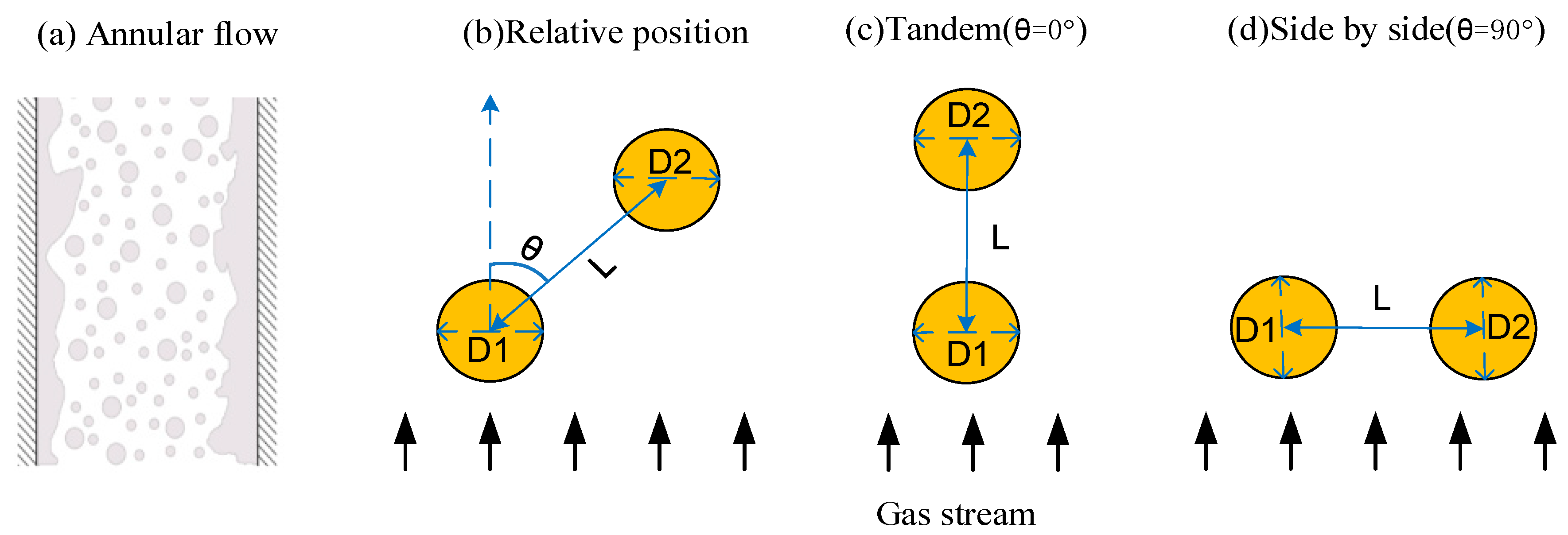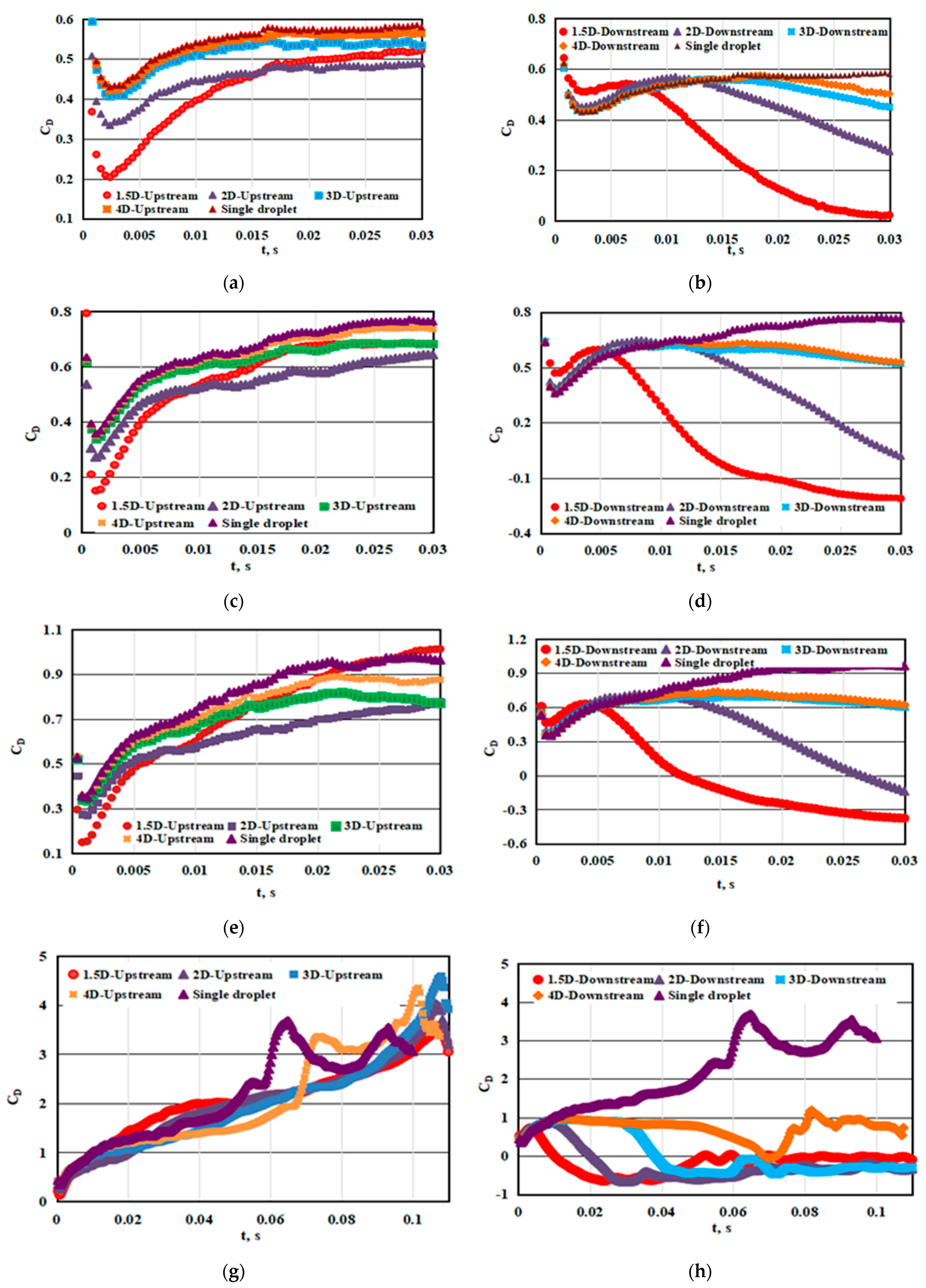Interactions between Two Deformable Droplets in Tandem Fixed in a Gas Flow Field of a Gas Well
Abstract
:1. Introduction
2. Method
2.1. Governing Equations
2.2. Drag Force
2.3. Body Force
2.4. Geometry Setup and Mesh
3. Results and Discussion
3.1. Simulation Validation
3.2. Dynamics of a Single Isolated Droplet in Gas Flow Field of Gas Well
3.2.1. Physical Parameters
3.2.2. Single Droplet Simulation Results
3.3. Interactions between Two Droplets in Tandem
3.3.1. For a Separating Space of 1.5D
3.3.2. For Separating Spaces between Droplets of 2D, 3D, and 4D
3.3.3. Correlation of Drag Coefficient of Downstream Droplet
4. Conclusions
Author Contributions
Funding
Acknowledgments
Conflicts of Interest
References
- Turner, R.G.; Hubbard, M.G.; Dukler, A.E. Analysis and prediction of minimum flow rate for the continuous removal of liquids from gas wells. J. Pet. Technol. 1969, 21, 75–82. [Google Scholar] [CrossRef]
- Coleman, S.B.; Clay, H.B.; McCurdy, D.G. A new look at predicting gas-well load-up. J. Pet. Technol. 1991, 43, 329–333. [Google Scholar] [CrossRef]
- Nosseir, M.A.; Darwich, T.A.; Sayyouh, M.H. A new approach for accurate prediction of loading in gas wells under different flowing conditions. In Proceedings of the SPE Production Operation Symposium, Oklahoma City, OK, USA, 9–11 March 1997. [Google Scholar]
- Li, M.; Li, S.L.; Sun, L.T. New view on continuous-removal liquids from gas wells. SPE Permian Basin Oil Gas Recovery Conf. 2002, 17, 42–46. [Google Scholar] [CrossRef]
- Zhou, D.; Yuan, H.A. A new model for predicting gas-well liquid loading. SPE Prod. Oper. 2010, 25, 172–181. [Google Scholar] [CrossRef]
- Wang, Z.B.; Bai, H.F.; Zhu, S.Y.; Li, Y.C.; Zhong, H.Q. An entrained model for predicting minimum flow rate for the continuous removal of liquids from gas wells. SPE J. 2015, 22, 1135–1144. [Google Scholar] [CrossRef]
- Kim, I.; Elgobashi, S.; Sirignano, W. Three-dimensional flow over two spheres placed sidy by side. J. Fluid Mech. 1993, 246, 465–488. [Google Scholar] [CrossRef]
- Tusji, T.; Narutomi, R.; Yokomine, T.; Ebara, S.; Shimizu, A. Unsteady three-dimensional simulation of interactions between flow and two particles. Int. J. Multiph. Flow 2003, 29, 1431–1450. [Google Scholar]
- Zhu, C.; Lam, K.; Chu, H.H.; Tang, X.D.; Liu, G. Drag forces of interacting spheres in power-law fluids. Mech. Res. Commun. 2003, 30, 651–662. [Google Scholar]
- Prahl, L.; Hölzer, A.; Arlov, D.; Revstedt, J.; Sommerfeld, M.; Fuchs, L. On the interaction between two fixed spherical particles. Int. J. Multiph. Flow 2007, 33, 707–725. [Google Scholar] [CrossRef]
- Yoon, D.H.; Yang, K.S. Flow-induced forces on two nearby spheres. Phys. Fluids 2007, 19, 98–103. [Google Scholar] [CrossRef] [Green Version]
- Prahl, L.; Jadoon, A.; Revstedt, J. Interaction between two spheres placed in tandem arrangement in steady and pulsating flow. Int. J. Multiph. Flow 2009, 35, 963–969. [Google Scholar] [CrossRef]
- Jadoon, A.; Prahl, L.; Revstedt, J. Dynamic interaction of fixed dual spheres for several configurations and inflow conditions. Eur. J. Mech. B Fluids 2010, 29, 43–52. [Google Scholar] [CrossRef]
- Kékesi, T.; Amberg, G.; Prahl Wittberg, L. Drop deformation and breakup in flows with shear. Chem. Eng. Sci. 2016, 140, 319–329. [Google Scholar] [CrossRef]
- Kékesi, T.; Altimira, M.; Amberg, G.; Prahl Wittberg, L. Interaction between two deforming liquid drops in tandem and various off-axis arrangements subject to uniform flow. Int. J. Multiph. Flow 2019, 112, 193–218. [Google Scholar] [CrossRef]
- Wang, Z.B.; Yang, Z.W.; Guo, L.J.; Zhao, R.J. A volume of fluid simulation of the steady deformation and the drag of a single droplet in a flowing gas. J. Hydrodyn. 2021, 33, 334–346. [Google Scholar] [CrossRef]
- Raju, M.; Sirignano, W. Interaction between two vaporizing droplets in an intermediate Reynolds number flow. Phys. Fluids 1990, 2, 1780–1796. [Google Scholar] [CrossRef]
- Chiang, C.; Sirignano, W. Interacting, convecting, vaporizing fuel droplets with variable properties. Int. J. Heat Mass. Transfer. 1993, 36, 875–886. [Google Scholar] [CrossRef]
- Kim, I.; Elgobashi, S.; Sirignano, W. Three-dimensional flow computation for two interacting, moving droplets. In Proceedings of the AIAA 30th Aerospace Sciences Meeting, Reno, NV, USA, 6–9 January 1992. [Google Scholar]
- Chen, S.L.; Guo, L.J. Viscosity effect on regular bubble entrapment during drop impact in to a deep pool. Chem. Eng. Sci. 2014, 109, 1–16. [Google Scholar] [CrossRef]
- Zhang, L.X.; Zhou, Z.C.; Shao, X.M. Numerical investigation on the drag force of a single bubble and bubble swarm. J. Hydrodyn. 2020, 32, 1043–1049. [Google Scholar] [CrossRef]
- Weller, H.G. A New Approach to VOF-Based Interface Capturing Methods for Incompressible and Compressible Flow; OpenCFD Ltd.: London, UK, 2008. [Google Scholar]
- Jasak, H. Error Analysis and Estimation for the Finite Volume Method with Applications to Fluid Flows; Medicine: London, UK, 1996. [Google Scholar]








Publisher’s Note: MDPI stays neutral with regard to jurisdictional claims in published maps and institutional affiliations. |
© 2021 by the authors. Licensee MDPI, Basel, Switzerland. This article is an open access article distributed under the terms and conditions of the Creative Commons Attribution (CC BY) license (https://creativecommons.org/licenses/by/4.0/).
Share and Cite
Wang, Z.; Sun, T.; Yang, Z.; Zhu, G.; Shi, H. Interactions between Two Deformable Droplets in Tandem Fixed in a Gas Flow Field of a Gas Well. Appl. Sci. 2021, 11, 11220. https://doi.org/10.3390/app112311220
Wang Z, Sun T, Yang Z, Zhu G, Shi H. Interactions between Two Deformable Droplets in Tandem Fixed in a Gas Flow Field of a Gas Well. Applied Sciences. 2021; 11(23):11220. https://doi.org/10.3390/app112311220
Chicago/Turabian StyleWang, Zhibin, Tianli Sun, Zhongwei Yang, Guo Zhu, and Hongyan Shi. 2021. "Interactions between Two Deformable Droplets in Tandem Fixed in a Gas Flow Field of a Gas Well" Applied Sciences 11, no. 23: 11220. https://doi.org/10.3390/app112311220
APA StyleWang, Z., Sun, T., Yang, Z., Zhu, G., & Shi, H. (2021). Interactions between Two Deformable Droplets in Tandem Fixed in a Gas Flow Field of a Gas Well. Applied Sciences, 11(23), 11220. https://doi.org/10.3390/app112311220




